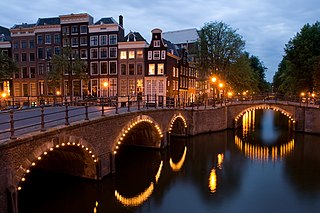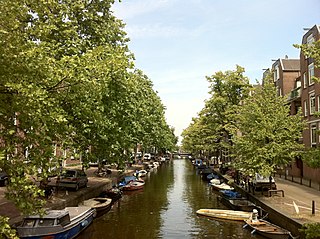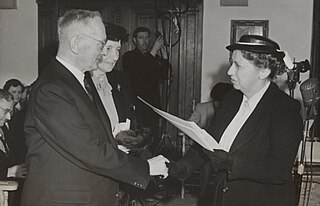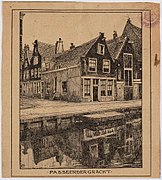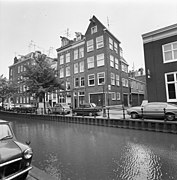History
The canal originated when the canal belt was dug south from the Brouwersgracht starting in 1612. In the 19th century six of the eleven Jordaan canals were filled in. Only the Bloemgracht, Egelantiersgracht, Lauriergracht, Looiersgracht and Passeerdersgracht remained, connecting to the Prinsengracht, Keizersgracht, Herengracht, Singel, Lijnbaansgracht, Brouwersgracht, Leliegracht and Leidsegracht.
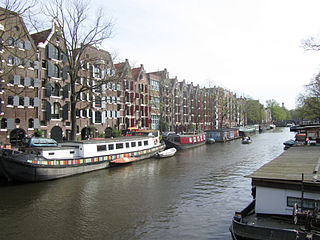
The Brouwersgracht is a canal in Amsterdam that connects the Singel with the Singelgracht. The canal marks the northwestern border of the Grachtengordel. Between the Prinsengracht and the Singelgracht the Brouwersgracht forms the northern border of the Jordaan neighborhood.

The Bloemgracht is a canal in the Jordaan district of Amsterdam, the Netherlands. It connects the Prinsengracht with the Lijnbaansgracht and runs between and parallel to Nieuwe Leliestraat and Bloemstraat in the Amsterdam-Centrum district. The canal is named after the Bolwerk de Bloem, later called Rijkeroord. From 1614 the Blom windmill was here. It was moved to Haarlemmerweg in 1878.
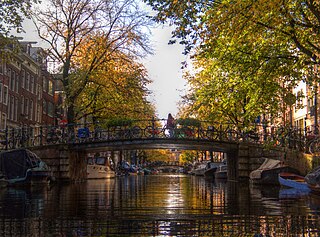
The Egelantiersgracht in Amsterdam is a canal in the Jordaan neighbourhood in the Amsterdam-Centrum borough. The canal lies between the Prinsengracht and the Lijnbaansgracht.
The former Hogeschool voor Economische Studies (School of Economic Studies; HES) / First Public Trade School on the corner of Passeerdersgracht, is located on a filled-in part of Lijnbaansgracht: the Raamplein.
In many places in the Jordaan there were so-called gangen, alleys or corridors between the houses. These narrow alleys gave access to rear areas that held courtyards where the less fortunate lived in often dilapidated shelters, often built illegally. For example, in the "Walenhoek" on the Passeerdersgracht there was the "Walengang" between numbers 15 and 17. This corridor was demolished in 1850 for construction of the former Toevlugt voor Behoeftigen on Passeerdersgracht 9–19.
The building of the former Arbeidsbeurs on Passeerdersgracht 28-32, at the corner of Tweede Passeerdersdwarsstraat, was designed around 1915 by architects Joan van der Mey and Piet Kramer. Until the summer of 2012 this monumental building housed one of the two branches of the Amsterdam youth circus Circus Elleboog. Elleboog then moved to a new location, Laan van Spartaan in Amsterdam-West.

Joan (Jo) Melchior van der Mey was a Dutch architect best known for the landmark Scheepvaarthuis building in Amsterdam located at Prins Hendrikkade, 1912.

Pieter Lodewijk (Piet) Kramer was a Dutch architect, one of the most important architects of the Amsterdam School.

Amsterdam-West is a borough of Amsterdam, Netherlands, to the west of the centre of the city. This borough was formed in 2010 through the merging of four former boroughs Oud West, Westerpark, De Baarsjes and Bos en Lommer.
Most of the canal houses on the Passeerdersgracht have been converted into residential houses.

A canal house is a house overseeing a canal. These houses are often slim, high and deep. Because of the danger of flooding the front door is sometimes higher up and only accessible via stairs. The floor of the main storey lies about seven to nine steps above street level. Many stoops disappeared in the 19th century when entrances were moved to the basement.

The Jordaan is a neighbourhood of the city of Amsterdam, Netherlands. It is part of the borough of Amsterdam-Centrum. The area is bordered by the Singelgracht canal and the neighbourhood of Frederik Hendrikbuurt to the west; the Prinsengracht to the east; the Brouwersgracht to the north and the Leidsegracht to the south. The former canal Rozengracht is the main traffic artery through the neighbourhood.
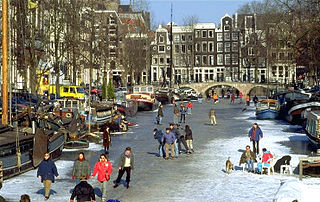
The Keizersgracht is a canal in Amsterdam, the Netherlands. It is the second of the three main Amsterdam canals that together form the Grachtengordel, or canal belt, and lies between the inner Herengracht and outer Prinsengracht.
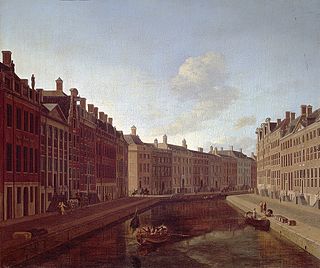
The Herengracht is the second of four Amsterdam canals belonging to the canal belt and lies between the Singel and the Keizersgracht. The Gouden Bocht in particular is known for its large and beautiful canal houses.

Amsterdam, capital of the Netherlands, has more than one hundred kilometers of grachten (canals), about 90 islands and 1,500 bridges. The three main canals, dug in the 17th century during the Dutch Golden Age, form concentric belts around the city, known as the Grachtengordel. Alongside the main canals are 1550 monumental buildings. The 17th-century canal ring area, including the Prinsengracht, Keizersgracht, Herengracht and Jordaan, were listed as UNESCO World Heritage Site in 2010, contributing to Amsterdam's fame as the "Venice of the North".

The Grachtengordel is a neighborhood in Amsterdam, Netherlands located in the Centrum district. The seventeenth-century canals of Amsterdam, located in the center of Amsterdam, were added to the UNESCO World Heritage List in August 2010. The Amsterdam Canal District consists of the area around the city’s four main canals: the Singel, the Herengracht, the Keizersgracht, and the Prinsengracht. From the Brouwersgracht, the canals are generally parallel with one another, leading gradually southeast into the Amstel river.

The 9 Straatjes' is a neighborhood of Amsterdam, Netherlands located in the borough Centrum. It consists of nine side streets of the Prinsengracht, Keizersgracht, Herengracht and Singel in central Amsterdam which have been promoting themselves with that name since the 1990s. Together they form a sub-neighborhood within the larger western Grachtengordel, one with many small and diverse shops and restaurants. The construction in this area goes back to the first half of the 17th century.

The Rozengracht is a street in the Jordaan neighbourhood of Amsterdam. It runs between the Prinsengracht at the Westermarkt and the Singel canal at De Clercqstraat. The name means "Rose canal".
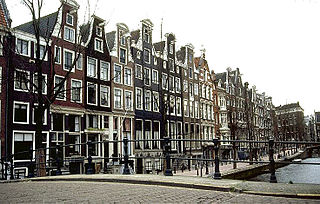
The Leidsegracht is a canal in Amsterdam, the Netherlands. It is a cross-canal in Amsterdam-Center hat connects Herengracht, Keizersgracht, Prinsengracht and Lijnbaansgracht and flows into the Singelgracht at Marnixstraat.

The Grimburgwal is a small canal and street in the center of Amsterdam.

The Looiersgracht is a short canal in Amsterdam, between Prinsengracht and Lijnbaansgracht in the Jordaan neighborhood of the Amsterdam-Centrum district. The Looiersgracht borders the Grachtengordel. The Oude Looiersstraat runs parallel to the canal, and the Eerste, Tweede and Derde Looiersdwarsstraat are side streets entering the north side.

The Leliegracht is a canal in Amsterdam between Herengracht and Prinsengracht. The canal lies within the west of the Grachtengordel in the Jordaan neighborhood of the Amsterdam-Centrum district.

The Raamgracht is a canal in central Amsterdam that runs from the Kloveniersburgwal to the Zwanenburgwal. The Groenburgwal, Verversstraat and Zanddwarsstraat lead to the Raamgracht. Bridge 225 over the canal is beside the Kloveniersburgwal, and Theo Boschbrug over the canal is beside the Zwanenburgwal.

The Plantage Muidergracht is a canal and street in the Plantage neighborhood of Amsterdam. On and along the Plantage Muidergracht, near Roeterseiland, are some of the buildings of the University of Amsterdam, originally built for courses or subfaculties of physics, chemistry, biology, environmental science and mathematics, but now used by other faculties.
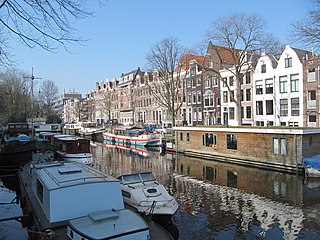
The Achtergracht is a short canal in Amsterdam, located between Frederiksplein and the Amstel, parallel to the Prinsengracht. The Achtergracht is located in the eastern part of the Grachtengordel.
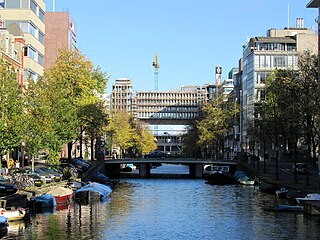
The Nieuwe Achtergracht is a canal in Amsterdam in the east of the [[Grachtengordel] in the Amsterdam-Centrum district. It runs parallel to the Nieuwe Prinsengracht and connects the Onbekendegracht with the Plantage Muidergracht. The canal is crossed by Weesperstraat and Roetersstraat.
This page is based on this
Wikipedia article Text is available under the
CC BY-SA 4.0 license; additional terms may apply.
Images, videos and audio are available under their respective licenses.


